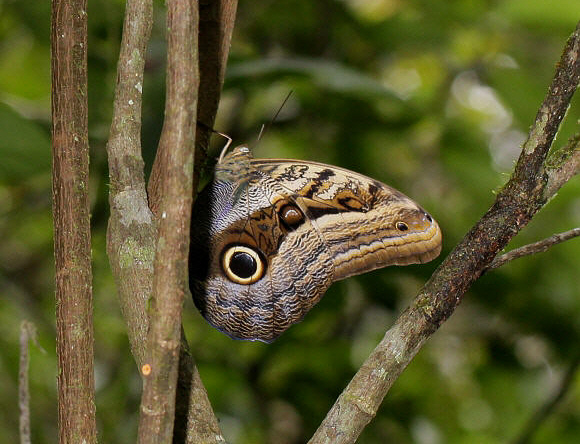 Caligo oileus umbratilis, Tingo Maria, Peru – Adrian Hoskins
Caligo oileus umbratilis, Tingo Maria, Peru – Adrian Hoskins
Introduction
A few decades ago the Owl butterflies were considered to be members of a now defunct family, the Brassolidae. Following the revisions of Erlich ( 1958 ) and Ackery ( 1984 ), all of the butterflies with only two pairs of walking legs were placed within the Nymphalidae. The Brassolidae were reduced in rank to a subfamily Brassolinae, and then relegated further to become the Brassolini – a tribe within the Morphinae.
The Morphinae includes about 150 neotropical species, 93 of which are placed in the tribe Brassolini. Of these, 73 are placed in the Brassolina – a subtribe which includes Blepolenis, Brassolis, Dynastor, Caligopsis, Catoblepia, Dasyopthalma, Mielkella, Opsiphanes, Mimoblepia, Opoptera, Selenophanes, Penetes, Eryphanis, Orobrassolis and Caligo. All are crepuscular or nocturnal in behaviour, although a few species also fly by day in the darkest areas within their habitats. They are among the oldest genera of butterflies on Earth – Brassolis for example first evolved in the late Eocene Period, about 40 million years ago.
The 21 Caligo species are known colloquially as Owl butterflies, due to the owl-like false eyes, and the feathery appearance of the underside wings.
Various theories have been proposed to explain the presence of the huge eyespots that adorn the underside hindwings of all species. The butterflies rest for very long periods on tree trunks and can be quite difficult to spot, but if accidentally disturbed by a bird they take immediate flight and if seen from below with wings fully open could feasibly be mistaken for an owl. When at rest however, only one side of the wings can be seen at a time and the appearance then is not owl-like. Another theory states that the eyespot and surrounding dark areas are mimetic of a species of tree frog that is said to rest on tree trunks where Owl butterflies are seen. It is however difficult to imagine what possible advantage a butterfly might have in resembling a tree frog !
A more rational likelihood is that the eyespot functions as a decoy. Caligo butterflies have a slow flapping flight, so a bird could easily follow one to it’s resting place. Once it has settled however the mottled patterning provides the butterfly with superb camouflage against the bark of a tree trunk, with only the eyespot remaining prominent. Birds don’t direct their beaks aimlessly – they normally aim for the head or body of a butterfly, but when the butterfly is well camouflaged they would aim instead at the most obvious and prominent feature, which in this case is the eyespot.
The underside markings of most Caligo species are prone to variation, which often causes confusion in identification. C. oileus can be confused with oedipus, but the upperside forewings of the former have broad suffused yellowish median bands, and the upperside hindwings are flushed with deep blue. In oedipus the bands are much narrower and whiter, and the whole upperside is flushed with greyish-blue.
Caligo oileus occurs from Panama to Bolivia.
Habitats
This species inhabits cloudforest habitats at altitudes between about 600-1600m.
Lifecycle
Owl butterfly eggs are parasitised by tiny Trichogrammatid wasps that ride from place to place on the hindwings of the butterflies. They only leave the female’s wings when she lays eggs, and then return, to be transported to the next egg laying site. The eggs laid by any individual female may be laid either singly, or in groups of 20 or more, on Heliconia leaves ( Heliconiaceae ).
The larvae are gregarious. Cannibalism does not apparently occur despite the fact that aggregations may include small and vulnerable 1st and 2nd instar larvae alongside fully grown specimens. When full grown they are dull brown, marked with darker longitudinal stripes. They have prominent forked tails, and a crown of horns on their heads. The larvae are nocturnal, and rest during daylight hours on dead leaves at the base of the foodplants, where they are superbly camouflaged. They appear to have some form of chemical defence, as they are ignored by marauding Eciton soldier ants.
The large stocky pupa is pale brown with darker streaks and closely resembles a bit of dead foliage. It is formed hanging by the cremaster from woody stems or amongst clumps of dead leaves.
Adult behaviour
Caligo butterflies are usually encountered as singletons, flying just before dusk along narrow trails. They are strongly attracted to rotting plantain and other fruit on the forest floor. If alarmed they fly off in an ungainly fashion, with the flapping of their wings clearly audible. Normally they fly only a few metres at a time, and settle on tree trunks, but if they attempt to land on foliage they often fail to maintain their grip, and are forced to fly off again and settle elsewhere.
They continue flying throughout the night, and are often attracted into buildings by artificial lighting. Just before dawn they seek out narrow tree trunks, on which they roost during daylight hours at a height of between 1-2 metres above ground level. On particularly dull and damp mornings they will continue flying, sometimes in quite open areas along the edge of forest roads.
I once observed a Caligo nectaring at flowers in mid-elevation rainforest in Ecuador, but they more usually feed at fallen fruit on the forest floor, and can be baited with rotting bananas or plantain.
Owl butterflies are known to live for up to 3 months in captivity but it is not known how long they live in the wild.

Caligo oileus umbratilis, Rio Kosnipata valley, Manu, Peru – Adrian Hoskins
